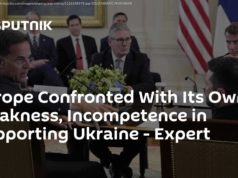 When a devastating international crisis brings with it an inevitable surfeit of topical documentaries on the subject, audiences can be overwhelmed to the point of inactivity. No one outside the festival circuit has either the inclination or the constitution to watch them all, while the options can look indistinguishably downbeat even to the conscientious. The ongoing Syrian Civil War has been abundantly covered on screen of late — with three Syria-related feature docs premiering at Sundance this year alone. But a standout candidate for crossover distribution may have emerged in “ Last Men in Aleppo.” Feras Fayyad ’s viscerally immediate, exquisitely realized portrait of the Syrian Civil Defense’s “White Helmet” volunteers at the frontline of the conflict in Syria’s decimated capital may not be the most comprehensively explanatory or analytical film yet made on the war, but it’s the one that provides viewers with the most sensorily vivid and empathetic sense yet of how it feels to live (and die) through the carnage.
When a devastating international crisis brings with it an inevitable surfeit of topical documentaries on the subject, audiences can be overwhelmed to the point of inactivity. No one outside the festival circuit has either the inclination or the constitution to watch them all, while the options can look indistinguishably downbeat even to the conscientious. The ongoing Syrian Civil War has been abundantly covered on screen of late — with three Syria-related feature docs premiering at Sundance this year alone. But a standout candidate for crossover distribution may have emerged in “ Last Men in Aleppo.” Feras Fayyad ’s viscerally immediate, exquisitely realized portrait of the Syrian Civil Defense’s “White Helmet” volunteers at the frontline of the conflict in Syria’s decimated capital may not be the most comprehensively explanatory or analytical film yet made on the war, but it’s the one that provides viewers with the most sensorily vivid and empathetic sense yet of how it feels to live (and die) through the carnage.
Unsurprisingly awarded the Grand Jury Prize at Sundance, Fayyad’s film should have no trouble parlaying its Park City heat into extensive further festival play and acclaim, as well as offers from top documentary-specific distributors. Multi-platform release strategies are likely, aiming to engage audiences wary of venturing to theaters for such a heart-sinking chronicle. That said, the cinema is where “Last Men in Aleppo” firmly belongs. Together with co-director and editor Steen Johannessen, Fayyad brings a rigorous sense of craft and shock-and-awe scale to the film’s impressions of destruction, without impeding its anxious, on-the-hoof spontaneity. Any viewers coming to this after seeing “The White Helmets,” Netflix’s commendable, Oscar-nominated short on the SCD, needn’t fear seeing the same film again at greater length: This is a less cleanly packaged project, patient and nuanced in developing its individual human subjects and emotional stakes.
If anything, the Netflix film could serve as a useful primer for “Last Men in Aleppo,” which assumes a fair bit of knowledge on the audience’s part regarding who the White Helmets are and the circumstances that require them. Beginning with a rather cryptic, counterintuitive opening credit sequence featuring serenely floating goldfish — given poignant context later in the film — Fayyad often requires viewers to catch up with his most arresting visions, furnishing them with minimal journalistic detail. By leading with sheer, horrifying sensation as explosions shake the camera and buildings are reduced to dust before our very eyes, the film communicates the most universal human losses of the Syrian conflict. After all, finer political complexities aren’t the first thing on one’s mind when the fight is simply to stay alive and standing; Fayyad presents a warzone so exhausted and smoke-swathed for its participants that its very cause has disappeared amid the rubble.
With the conditions and textures of its environment established, however, the film is simple and pragmatic in its focus. Though it introduces and tracks a number of individual White Helmet workers, also giving a strong, moving sense of their strength as a collective, two emerge as particularly charismatic principals. Jovial family man Khaled Harah is the chief rallier of the group, attempting to keep his fellow volunteers motivated and hopeful as they negotiate human damage and debris that accumulates faster than they can sift through it, as bombs practically blur into background noise. His doughtiness, however, masks his own crisis of confidence, with his instincts caught between loyal service to his home city and the safeguarding of his wife and two daughters. “Something inside me tells me to leave,” he says to camera — though he knows that no one is likely to replace him on the rescue team if he does.
His more solemn partner Mahmoud, meanwhile, has put his philosophy studies on indefinite hold to join the White Helmets — grappling instead with weighty matters of ethics and accountability while out in the field, and struggling with the perception of heroism while other distraught citizens have the soul ripped out of them. “Last Men in Aleppo” follows his lead by refusing to sentimentalize their mission, sometimes to the point of brutal anticlimax. In one crushing scene, the extraction of a baby’s corpse in the wreckage and the discovery of its living but dumbfounded mother occur only seconds apart. There’s no triumph to be found in this job, only degrees of tragedy. A ghoulish sensibility even prevails on occasion, as workers try to discern the identity of a single severed foot, not long after they’re brusquely instructed to watch out for detached limbs in the fray.
Like its human subjects, the film is at pains to avoid self-congratulation as it strenuously puts this all to screen: The tone throughout is one of no-nonsense candor, not elevated martyrdom. Even so, it can hardly escape viewers’ notice that this frequently astonishing first-hand footage — shot over the course of a year between September 2015 and the fall of 2016 — has been obtained at immense risk to the lives of the filmmakers. That makes the care with which it has been composed and assembled all the more remarkable.
Even when caught directly in the crossfire, director of photography Fadi al Halabi and his crew of cameramen shoot with consistent poise and precision, keeping a constant eye out for human activity at the very edges of a scene; there’s even a perverse beauty at play in various dazzlingly lit images of pyrotechnic destruction and raging flames. Johannessen and co-editor Michael Bauer organize the footage with a keen sense of passing time, without imposing too much of a narrative structure on events that feel, to those affected, shapelessly futile. If a few too many of the film’s consecutive final scenes seem to draw to an ending — before a gut-wrencher of a closing chyron — one can understand the reluctance to let any of this material go spare.






